Submitted:
18 December 2023
Posted:
19 December 2023
You are already at the latest version
Abstract
Keywords:
1. Introduction
2. Literature Review
2.1. State-of-art of Face Recognation
2.2. Initial Considerations on the Frescoes Iconographic Interpretation
3. Materials and Methods
3.1. Iconographic Analysis
3.2. Deep Face Recognition Model
4. Results
4.1. Background
4.1.1. Historical-Political-Artistic Framework
4.1.2. Oil paintings of Nuno Gonçalves
4.1.3. The Frescoes from the apse
4.2. Experimental Campaign
5. Discussion
6. Conclusions
Author Contributions
Funding
Funding
Acknowledgments
Conflicts of Interest
References
- Soto-Martin, O.; Fuentes-Porto, A.; Martin-Gutierrez, J. A Digital Reconstruction of a Historical Building and Virtual Reintegration of Mural Paintings to Create an Interactive and Immersive Experience in Virtual Reality, Appl. Sci. 2020, 10, 597, 23 pages. [Google Scholar] [CrossRef]
- Zhong, G. A computer vision-aided analysis of facial similarities in Song dynasty imperial portraits. In Proceedings of the IS&T International Symposium on Electronic Imaging Computer Vision and Image Analysis of Art 2023; Society for Imaging Science and Technology, Springfield, USA; Electronic Imaging, 2023, pp. 212-1 - 212-6. [CrossRef]
- Pereira, P. Leitura iconológica / A Charola do Convento de Cristo em Tomar. In Abóbada da Charola do Convento de Cristo / Restauro, 1st ed.; IPPAR: Lisboa, Portugal, 2000; pp. 33–46. [Google Scholar]
- Moreira, R. Jerónimos, 1st ed.; Editorial Verbo; IPPC: Lisboa, Portugal, 1987; pp. 1–48. [Google Scholar]
- Serrão, V. História da Arte em Portugal /O Renascimento e o Maneirismo. Ed. Presença, Queluz de Baixo, Barcarena. 2002, pp. 87.
- Panofsky, E. O Significado nas Artes Visuais. Translation of the original book Meaning in the Visual Arts. Editorial Presença, Lda. Lisboa, 1989; pp. 31-44.
- Gonçalves, M. S.; Guimarães, P. M. 1999. Paróquia de Santa Leocádia. Arquivo Distrital de Vila Real: Guia de Fundos. Vila Real: IAN/TT. 2 vols. ISBN 972-9022-18-6. PT/ADVR/PRQ/PCHV29. https://digitarq.advrl.arquivos.pt (accessed on 5 /10/2023). /.
- Almeida, F. Relação de Igrejas e Honras. In História da Igreja em Portugal, 2nd ed.; Coimbra, Portugal, 1930; tomo 4, pp.112.
- de Goes, D. Chronica do Felicíssimo Rei D. Manuel. Scriptores Rerum Lusitanarum (Série A), Editors J. M. Teixeira de Carvalho and David Lopes, University of Coimbra Press: Coimbra, Portugal, 1926; 1ª parte, pp. 8-11 and pp. 13-14.
- Sereno, I.; Teixeira, R.; Noé, P. Igreja Paroquial de Santa Leocádia / Portugal, Vila Real, Chaves, Santa Leocádia, SIPA, 1994; 2003.
- Caetano, J. O Marão e as oficinas de pintura mural nos séculos XV e XVI, 1st ed.; Ed. Aparição: Lisboa, Portugal, 2001; pag. 32, pp. 36-48. [Google Scholar]
- Srinivasan, R.; Rudolph, C.; Roy-Chowdhury, A. Computerized Face Recognition in Renaissance Portrait Art. IEEE Signal Processing Magazine. 2015, 32, 85–94. [Google Scholar] [CrossRef]
- Gupta, A.; Mithun, N.C.; Rudolph, C.; Roy-Chowdhury, A.K. Deep learning-based identity verification in Renaissance portraits. In Proceedings of the 2018 IEEE International Conference on Multimedia and Expo (ICME), San Diego, CA, USA, 23-27 July 2018. 6 pages. [Google Scholar] [CrossRef]
- Chokkadi, S.; Sannidhan, M.S.; Sudeepa, K.B.; Abhir, B. A Study on various state of the art of the Art Face Recognition System using Deep Learning Techniques. International Journal of Advanced Trends in Computer Science and Engineering. 2019, 8, No.4, pp. 1590-1600. Available Online at http://www.warse.org/IJATCSE/static/pdf/file/ijatcse84842019.pdf (acessed in 18 November 2023). [CrossRef]
- Elmahmudi, A.; Ugail, H. Deep face recognition using imperfect facial data. Future Generation Computer Systems. 2019, 99, 213–225. [Google Scholar] [CrossRef]
- Hsiao, J.H.; An, J.; Zheng, Y.; Chan, A.B. Do portrait artists have enhanced face processing abilities? Evidence from hidden Markov modeling of eye movements. J. Cognition. 2021, 211, 104616, 17 pags. [Google Scholar] [CrossRef]
- Ugail, H.; Edwards, H.; Benoy, T.; Brooke, C. Deep Facial Features for Analysing Artistic Depictions – A case Study in Evaluating 16th and 17th Century Old Master Portraits. In Proceedings of 2022 14th International Conference on Software, Knowledge, Information Management and Applications (SKIMA), 02-04 December 2022, Phnom Penh, Cambodia. Published by IEEE Xplore, 06 February 2023; 6 pags. [CrossRef]
- Huber, M.; Terhörst, P.; Kirchbuchner, F.; Damer, N.; Kuijper, A. Stating Comparison Score Uncertainty and Verification Decision Confidence Towards Transparent Face Recognition. In Proceedings of The 33rd British Machine Vision Conference 21st – 24th November 2022, London, UK. 13 pags. [CrossRef]
- Hangaragi, S.; Singh, T.; Neelima, N. Face Detection and Recognition Using Face Mesh and Deep Neural Network. Procedia Computer Science. 2023, 218, 741–749; [Google Scholar] [CrossRef]
- Zhong, G. A computer vision-aided analysis of facial similarities in Song dynasty imperial portraits. In Proceedings of the IS&T International Symposium on Electronic Imaging Computer Vision and Image Analysis of Art 2023; Society for Imaging Science and Technology, Springfield, USA; Electronic Imaging, 2023, pp. 212-1 - 212-6. [CrossRef]
- Son, M. Like Life: Royal Portraits of Joseon Dynasty (1392-1910) in Ritual Context. Phd Thesis, Faculty of the University of Kansas, 2018; pp. 1-10.
- Lane, B.G. Sacred versus Profane in Early Netherlandish Painting. Simiolus: Netherlands Quaterly for the History of Art 1988, 3, 106–115. [Google Scholar] [CrossRef]
- Pereira, P. Leitura iconológica / A Charola do Convento de Cristo em Tomar. In Abóbada da Charola do Convento de Cristo / Restauro, 1st ed.; IPPAR: Lisboa, Portugal, 2000; pp. 33–46. [Google Scholar]
- Moreira, R. Jerónimos, 1st ed.; Editorial Verbo; IPPC: Lisboa, Portugal, 1987; pp. 1–48. [Google Scholar]
- Serrão, V. História da Arte em Portugal /O Renascimento e o Maneirismo. Ed. Presença, Queluz de Baixo, Barcarena. 2002, pp. 87.
- Panofsky, E. O Significado nas Artes Visuais. Translation of the original book Meaning in the Visual Arts. Editorial Presença, Lda. Lisboa, 1989; pp. 31-44.
- Cristóvão, I. C. A principal riqueza que dali vem: os têxteis bordados indianos em Portugal nos séculos XVI e XVII, MSc in História da Arte, FCSH, Universidade Nova de Lisboa, Lisboa, Portugal, 2017; pp. 68-74.
- de Sousa, F. A indústria das sedas em Trás-os-Montes, durante o Antigo Regime (séculos XV a XVIII), Edições Afrontamento, Porto, Portugal, 2006; pp. 27-31.
- Ferreira, R. C. As caixas quinhentistas lacadas da zona do Índico, Master Science Thesis in Gestão dos Mercados de Arte, ISCTE Business School, Instituto Universitário de Lisboa, Lisboa, Portugal, 2012; pp. 22-62.
- Fernandes, M.T.C. Análise comparativa da pintura mural do Noroeste Peninsular (Galicia-Norte de Portugal, 1500-1565). PhD Thesis, Faculty of Geography and History, Department of History of Art, University of Santiago de Compostela, Santiago de Compostela, 2012.
- Moreno, H. B. Antecedentes e Significado Histórico. In A Batalha de Alfarrobeira, 1st ed.; Lourenço Marques, Moçambique, 1973; Reprint in Biblioteca Geral da Universidade de Coimbra, 1978; Volume 1, pp. 7-8, pp. 421-427.
- Malkiel-Jirmounsky, M. Problémes des Primitifs Portugais. Coimbra Ed., Coimbra, Portugal, 1941; p.20.
- Dias, J. A. Introdução; Rodrigues, A. M. S. A.; Duarte, L. M. A Propriedade; Maltez, J. A. O Estado e as Instituições; Mea, E. C. A. A Igreja em Reforma. In Nova História de Portugal. Portugal do Renascimento a Crise Dinástica, 1st ed.; direction of Serrão, J. and Oliveira Marques, A.H.; coordination of Alves Dias J. J.; Editorial Presença, Lisboa, Portugal, 1998; Volume 5, pp. 7-10, pp. 103-105, pp. 384-406, pp. 413-419.
- Chevalier, J and Cheerbrant, A. Dictionnaire des Symboles, 1st ed., Robert Laffont S.A., Publisher: Jupiter, Paris, France, 1982; “Deux”; “Double”.
- Caetano, J.O. Um Século de Pintura. in Nova História de Portugal. Portugal do Renascimento a Crise Dinástica ; 1st ed.; direction of Serrão, J. and Oliveira Marques, A.H.; coordination of Alves Dias J. J.; Editorial Presença, Lisboa, Portugal, 1998; Volume 5, pp. 564-568.
- Serrão, V. O bispo D. Fernando de Meneses Coutinho, um mecenas do Renascimento na Diocese de Lamego. In Proceedings of “Propaganda e Poder: Congresso Peninsular de História da Arte”, FLLisboa, Portugal, 5-8 May 1999; Ed. Colibri, 2000, pp. 259-283.
- Freitas, P.; Gonçalves, M. J. G. Painéis de S. Vicente de Fora: uma questão inútil, IN-CM, Col. Arte e Artistas, Lisboa, 1987, pp. 147-148.
- Serrão, V.M.G.V. Os Painéis de São Vicente da Sé de Lisboa (c. 1460-1470). in O Proto-Renascimento: os Painéis de São Vicente (Arte Moderna (Portugal), Faculdade de Letras da Universidade de Lisboa, Portugal, 2021, 7 pages. https://fenix.letras.ulisboa.pt/courses/am-portugalpo-565398084786511 (accessed on 19/09/2023).
- Rodrigues, D. Pintura Quatrocentista. O Episódio de Nuno Gonçalves ou a Oficina de Lisboa. In História da Arte Portuguesa, 1st ed.; direction of Paulo Pereira; Colecção Temas e Debates e Autores, ed. Círculo de Leitores, Lisboa, Portugal, 1995; Volume 1, pp. 485-513. ISBN 972-759-003-9.
- Flor, P. O Retrato na arte portuguesa nos séculos XV e XVI / problemas, metodologia, linhas de investigação. Revista de História da Arte, 2008, Nº5, pp. 121.
- Paviot, J. Le polyptyque de saint Vincent attribué à Nuno Gonçalves (Lisbone, Musée national d’art ancien). Essai d’interprétation. In Bulletin de la Societé Nationale des Antiquaires de France, 2009. pp. 276.
- Godinho, V. de M. Os painéis de Nuno Gonçalves. Caminhos de pesquisa e hipóteses de trabalho. In Revista de História, [S. l.], 1959, v. 18, n. 37, p. 149-154. [CrossRef]
- https://www.revistas.usp.br/revhistoria/article/view/107273, (accessed on 19/09/2023).
- Araújo, C. M. F. O Fresco de Monsaraz. O Espelho Social, Artístico e Político entre Tejo e Odiana, em Finais do Século XV. MSc Thesis in Sul Ibérico e Mediterrâneo – Especialidade em História Medieval, University of Évora, 2013, pp. 39.
- Freitas, P.; Gonçalves, M. J. G. Painéis de S. Vicente de Fora: uma questão inútil, IN-CM, Col. Arte e Artistas, Lisboa, 1987, pp. 137-170.
- Freitas, P.; Gonçalves, M. J. G. Painéis de S. Vicente de Fora: uma questão inútil, IN-CM, Col. Arte e Artistas, Lisboa, 1987, pp. 149-150.
- Paviot, J. Le polyptyque de saint Vincent attribué à Nuno Gonçalves (Lisbone, Musée national d’art ancien). Essai d’interprétation. In Bulletin de la Societé Nationale des Antiquaires de France, 2009. pp. 275.
- Freitas, P.; Gonçalves, M. J. G. Painéis de S. Vicente de Fora: uma questão inútil, IN-CM, Col. Arte e Artistas, Lisboa, 1987, pp. 153, 154.
- Paviot, J. Le polyptyque de saint Vincent attribué à Nuno Gonçalves (Lisbone, Musée national d’art ancien). Essai d’interprétation. In Bulletin de la Societé Nationale des Antiquaires de France, 2009. pp. 265.
- Serrão, J.V.S. Frei João Álvares. In História e Antologia da Literatura Portuguesa, Século XV, 1st ed.; Fundação Calouste Gulbenkian, Lisboa, Portugal, 1999; pp. 11-12.
- Baeta, C. A Envolvência dos Painéis, 1ª ed., Ed. Bubok Publishing S. L., Print in Portugal, 2016; pp. 49 a 53.
- Paviot, J. Le polyptyque de saint Vincent attribué à Nuno Gonçalves (Lisbone, Musée national d’art ancien). Essai d’interprétation. In Bulletin de la Societé Nationale des Antiquaires de France, 2009. pp. 260.
- Paviot, J. Le polyptyque de saint Vincent attribué à Nuno Gonçalves (Lisbone, Musée national d’art ancien). Essai d’interprétation. In Bulletin de la Societé Nationale des Antiquaires de France, 2009. pp. 271.
- Freitas, P.; Gonçalves, M. J. G. Painéis de S. Vicente de Fora: uma questão inútil, IN-CM, Col. Arte e Artistas, Lisboa, 1987, pp. 155, 156.
- Cf. ANTT. Chancelaria de D. Afonso V, lv. 18, fl. 25r. In Documentos das Chancelarias Reais anteriores a 1531 relativos a Marrocos 2nd ed.; Azevedo, P., Academia das Sciências de Lisboa, Lisboa, Portugal, 1915; tomo I (1415-1450), doc. 47, p. 510.
- Serrão, J.V.S. Frei João Álvares. In História e Antologia da Literatura Portuguesa, Século XV, 1st ed.; Fundação Calouste Gulbenkian, Lisboa, Portugal, 1999; pp. 11-12.
- De Sena, J. Os Painéis ditos de “Nuno Gonçalves”. Revista de História 1963, June 26(54):333, pp. 355-357. [CrossRef]
- Branco, F. O significado dos Painéis de S. Vicente. Summary of the book Os Novos Painéis de S. Vicente, 1st ed.; Chiado Editora. Lisboa, Portugal, 2018; pp. 17. Available online: triplov.com/o-significado-dos-paineis-de-s-vicente (acessed on 07/10/2023).
- Paviot, J. Le polyptyque de saint Vincent attribué à Nuno Gonçalves (Lisbone, Musée national d’art ancien). Essai d’interprétation. In Bulletin de la Societé Nationale des Antiquaires de France, 2009. pp. 273-274.
- Gaspar, J.G. A glimpse into the iconography of the Patroness of Aveiro: from 1470 (?) to 2008. Cultura [Online], 2010, Volume 27, pp. 123. Available online: http://journals.openedition.org/cultura/360 ; (acessed on 01/09/2023). [CrossRef]
- https://www.matriznet.dgpc.pt (accessed on 19/09/2023).
- Freitas, P. and Gonçalves, M. J. G. Painéis de S. Vicente de Fora: uma questão inútil, IN-CM, Col. Arte e Artistas, Lisboa, 1987, p. 58.
- Godinho, V. de M. Os painéis de Nuno Gonçalves. Caminhos de pesquisa e hipóteses de trabalho. Revista de História, 1959, [S. l.], Volume 18, n. 37, p. 149-154. https://www.revistas.usp.br/revhistoria/article/view/107273 (accessed on 19/09/2023). [CrossRef]
- de Freitas, I. V. D. Isabel de Coimbra, Insigne Rainha, 1432-1455. QUIDNOVI, QN- Edição e Conteúdos, S.A., Aveleda, Vila do Conde, Portugal, s.d.; pp. 21 a 26. ISBN – 978-989-554-790-6.
- “Maitre aux rinceaux d’or”. Livro de Horas de D. Duarte, Bruges, Flandres, 1401-1433; Iluminura “Anunciação aos Pastores”, fl. 120v, ANTT [PT/TT/ MSMB/ A/ L65/m0248. Available online: https://digitarq.arquivos.pt (accessed on 06/10/2023).
- Paviot, J. Le polyptyque de saint Vincent attribué à Nuno Gonçalves (Lisbone, Musée national d’art ancien). Essai d’interprétation. In Bulletin de la Societé Nationale des Antiquaires de France, 2009. pp. 270-277.
- Paviot, J. Le polyptyque de saint Vincent attribué à Nuno Gonçalves (Lisbone, Musée national d’art ancien). Essai d’interprétation. In Bulletin de la Societé Nationale des Antiquaires de France, 2009. pp. 267-268.
- Paviot, J. Le polyptyque de saint Vincent attribué à Nuno Gonçalves (Lisbone, Musée national d’art ancien). Essai d’interprétation. In Bulletin de la Societé Nationale des Antiquaires de France, 2009. pp. 267.
- Pereira, F. A. Dois retratos na Aveiro Quatrocentista: o túmulo de João de Albuquerque, Senhor de Angeja e o retrato de D. Joana. In Proceedings of 8as Jornadas de História Local e Património Documental de Aveiro, Aveiro e a Expansão Marítima Portuguesa 1400-1800, Aveiro, Portugal, 21-22 November 2014. Câmara Municipal de Aveiro, Ancora Editora, 1ª ed., Lisboa, Portugal, 2017; pp. 353-376.
- Da Paula, N. G. R. O culto a Santa Joana Princesa em Aveiro – memórias e percursos. Master Science Thesis, FLUP, Porto, 2018, pp. 19-31.
- Gaspar, J. G. A glimpse into the iconography of the Patroness of Aveiro: from 1470 (?) to 2008. CHAM — Centre for the Humanities. Cultura [online], Vol. 27 | 2010, pp. 122 and 123; doi: 10.4000/cultura.360; acessed on 28/09/2023. http://journals.openedition.org/cultura/360.
- Paviot, J. Le polyptyque de saint Vincent attribué à Nuno Gonçalves (Lisbone, Musée national d’art ancien). Essai d’interprétation. In Bulletin de la Societé Nationale des Antiquaires de France, 2009. pp. 276.
- Maltez, J. A. O Estado e as Instituições. In Nova História de Portugal. Portugal do Renascimento a Crise Dinástica, 1st ed.; direction of Serrão, J. and Oliveira Marques, A.H.; coordination of Alves Dias J. J.; Editorial Presença, Lisboa, Portugal, 1998; Volume 5, pp. 384-406.
- Reis, F.A.F. The Art of Ruling in Diogo Lopes Rebelo’s DE REPUBLICA PER REGEM GUBERNANDA and João de Barros’s “CLARIMUNDO”. Revista Signum, 2014, Volume 15, n.1, pp. 34.
- Dias, J. A. Introdução; Rodrigues, A. M. S. A.; Duarte, L. M. A. Propriedade; Maltez, J. A. O Estado e as Instituições; Mea, E. C. A. A Igreja em Reforma. In Nova História de Portugal. Portugal do Renascimento a Crise Dinástica, 1st ed.; direction of Serrão, J. and Oliveira Marques, A.H.; coordination of Alves Dias J. J.; Editorial Presença, Lisboa, Portugal, 1998; Volume 5, pp. 7-10, pp. 103-105, pp. 384-406, pp. 413-419.

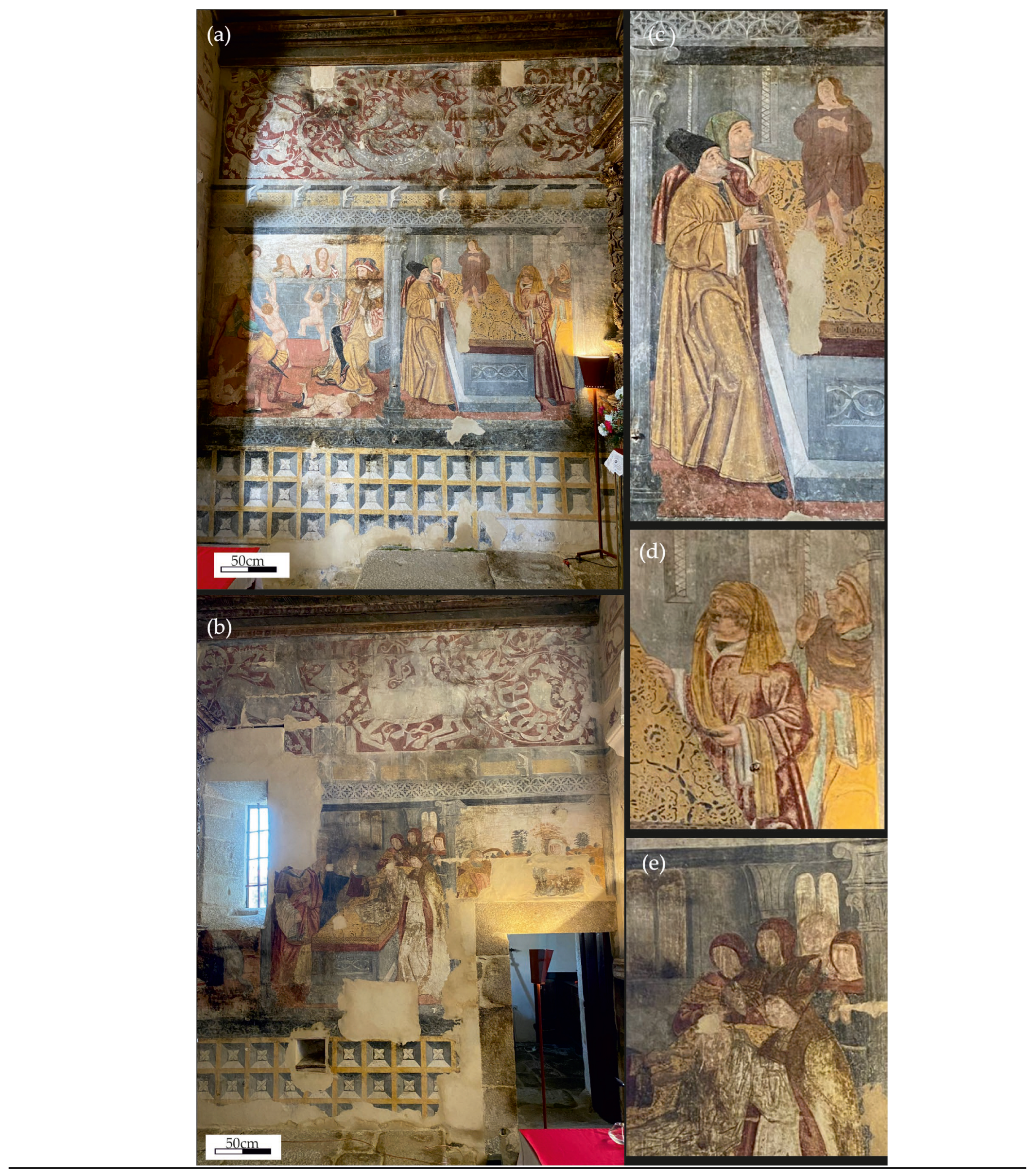
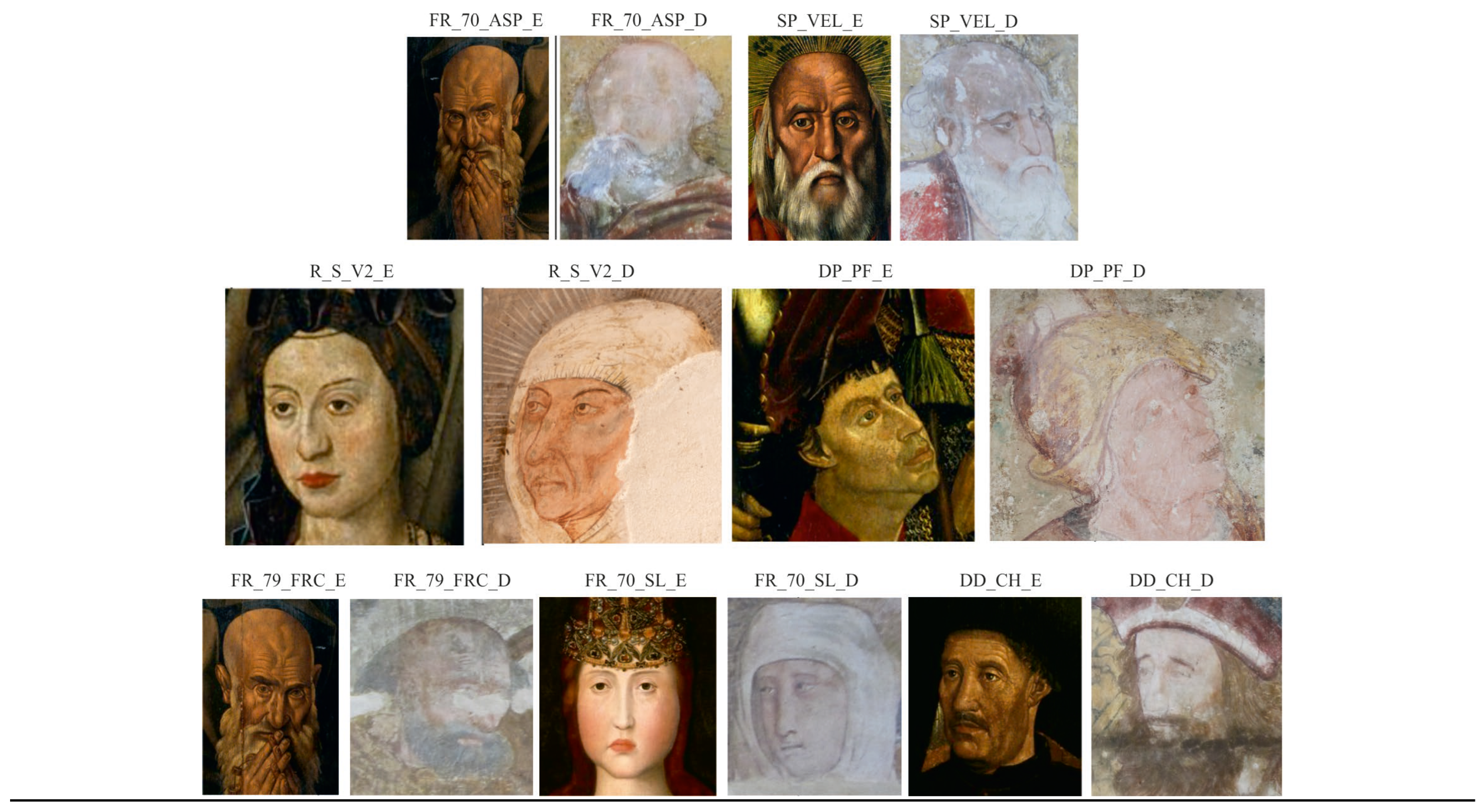
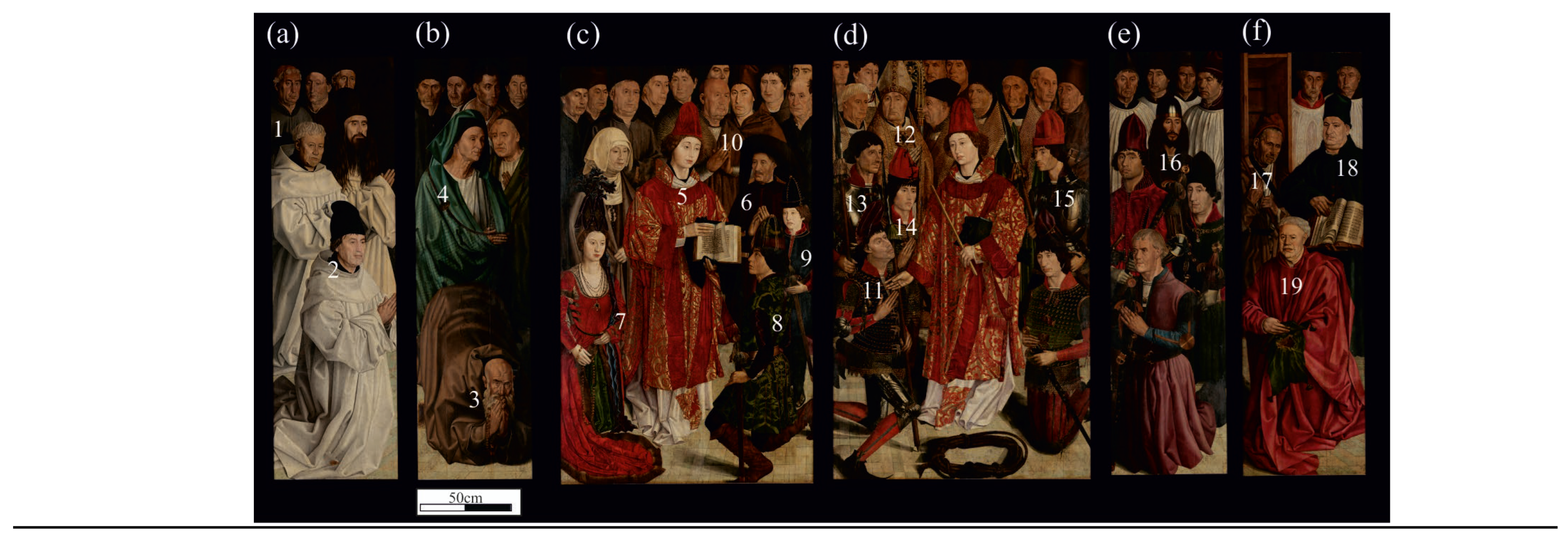
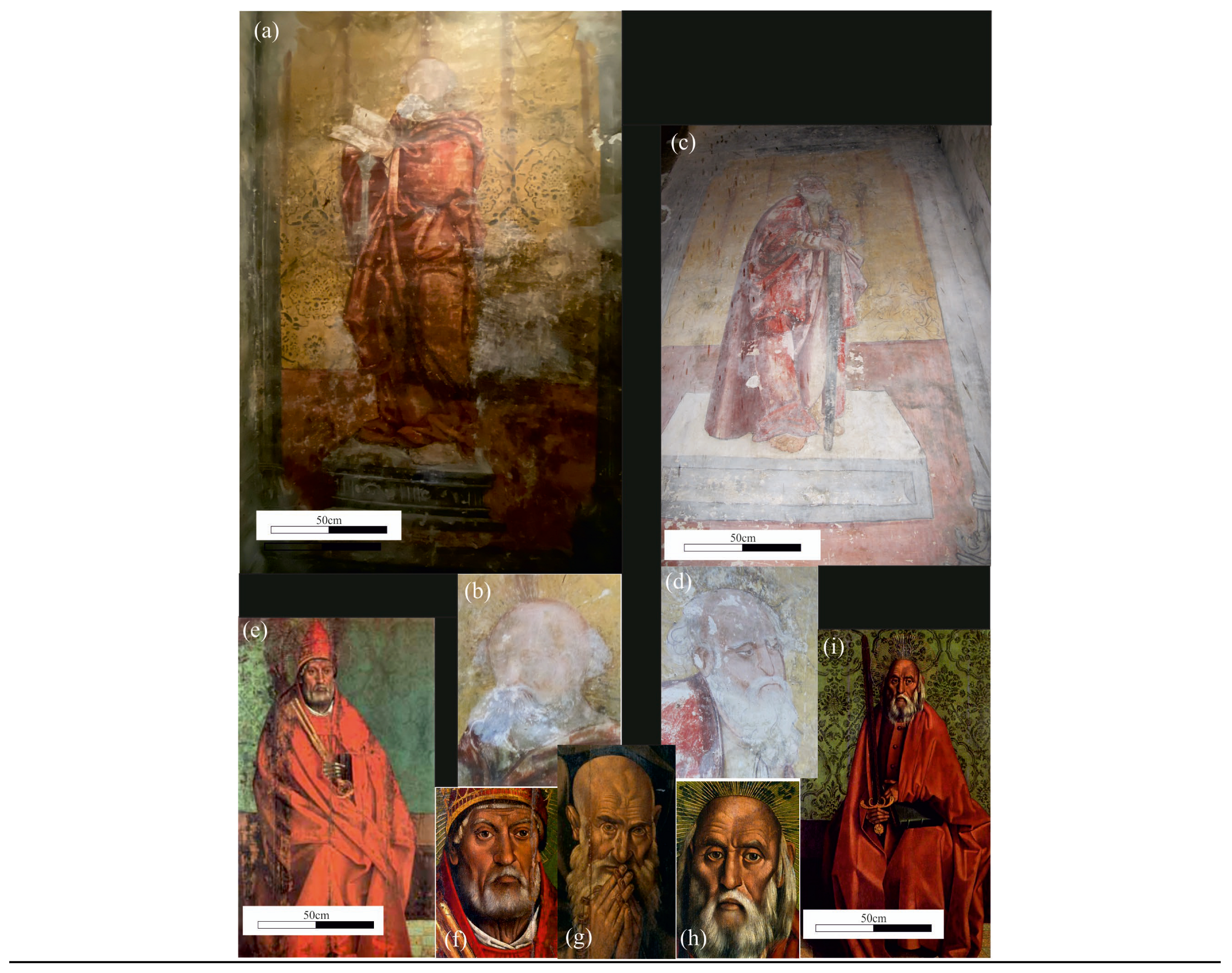

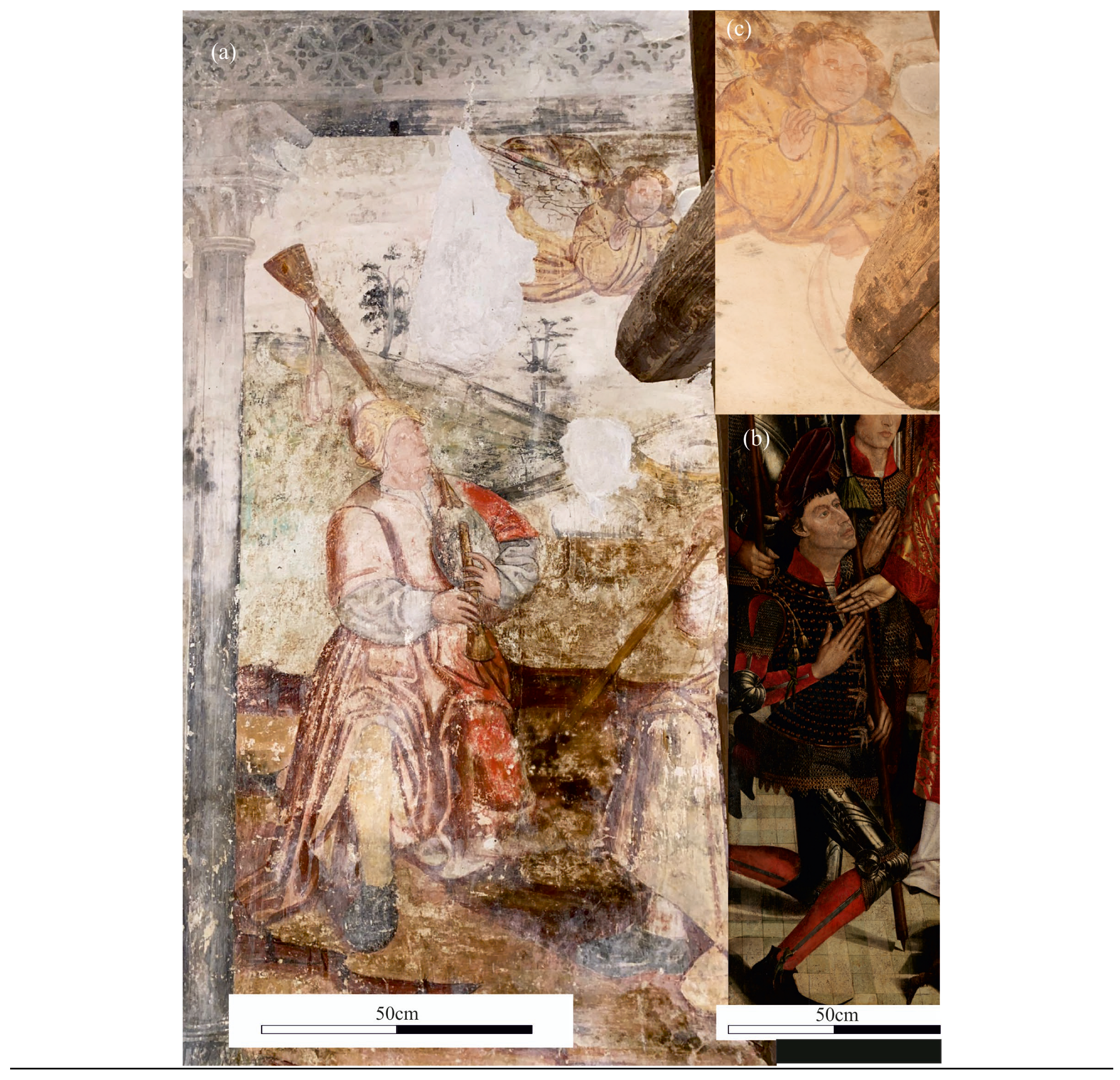

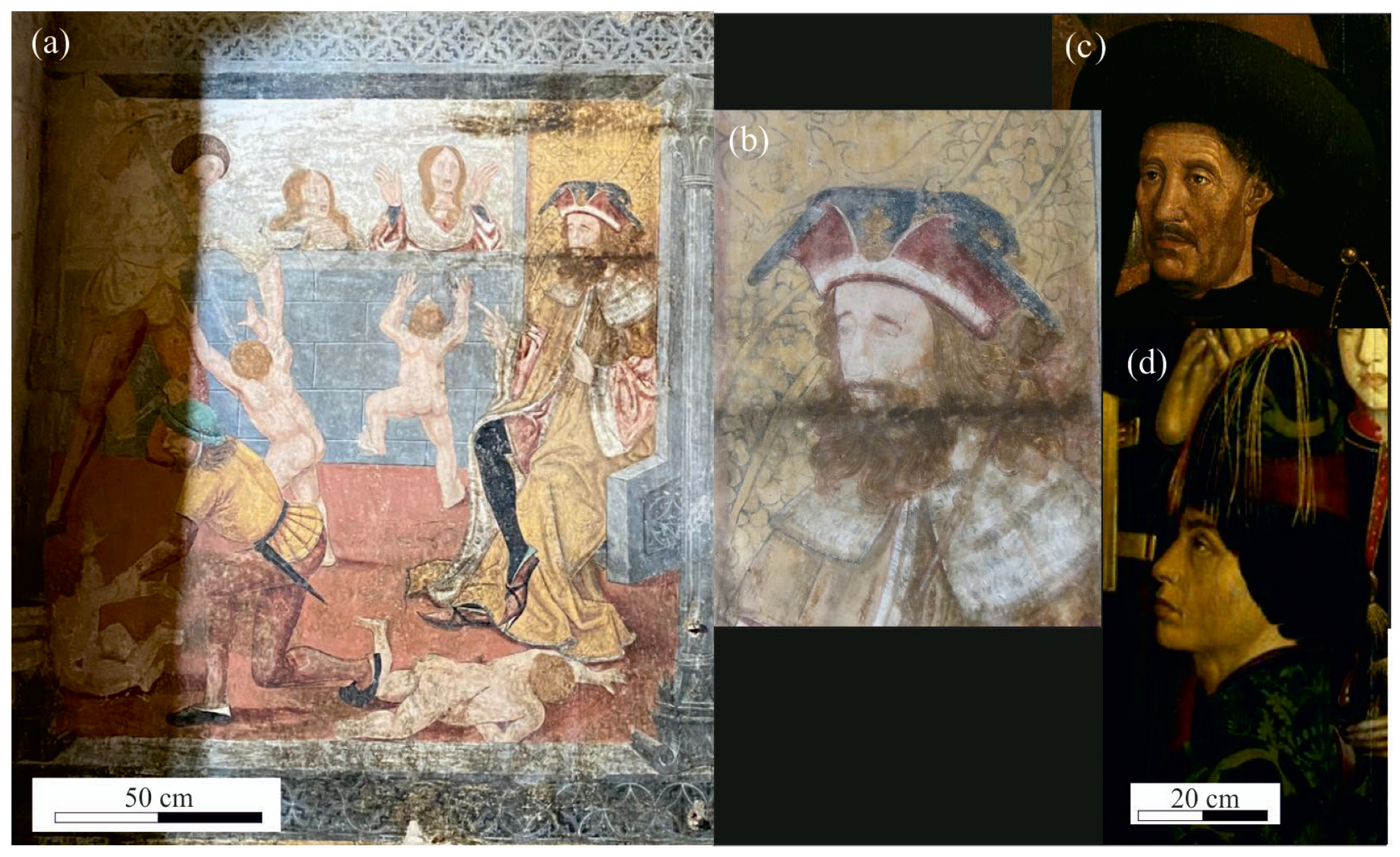
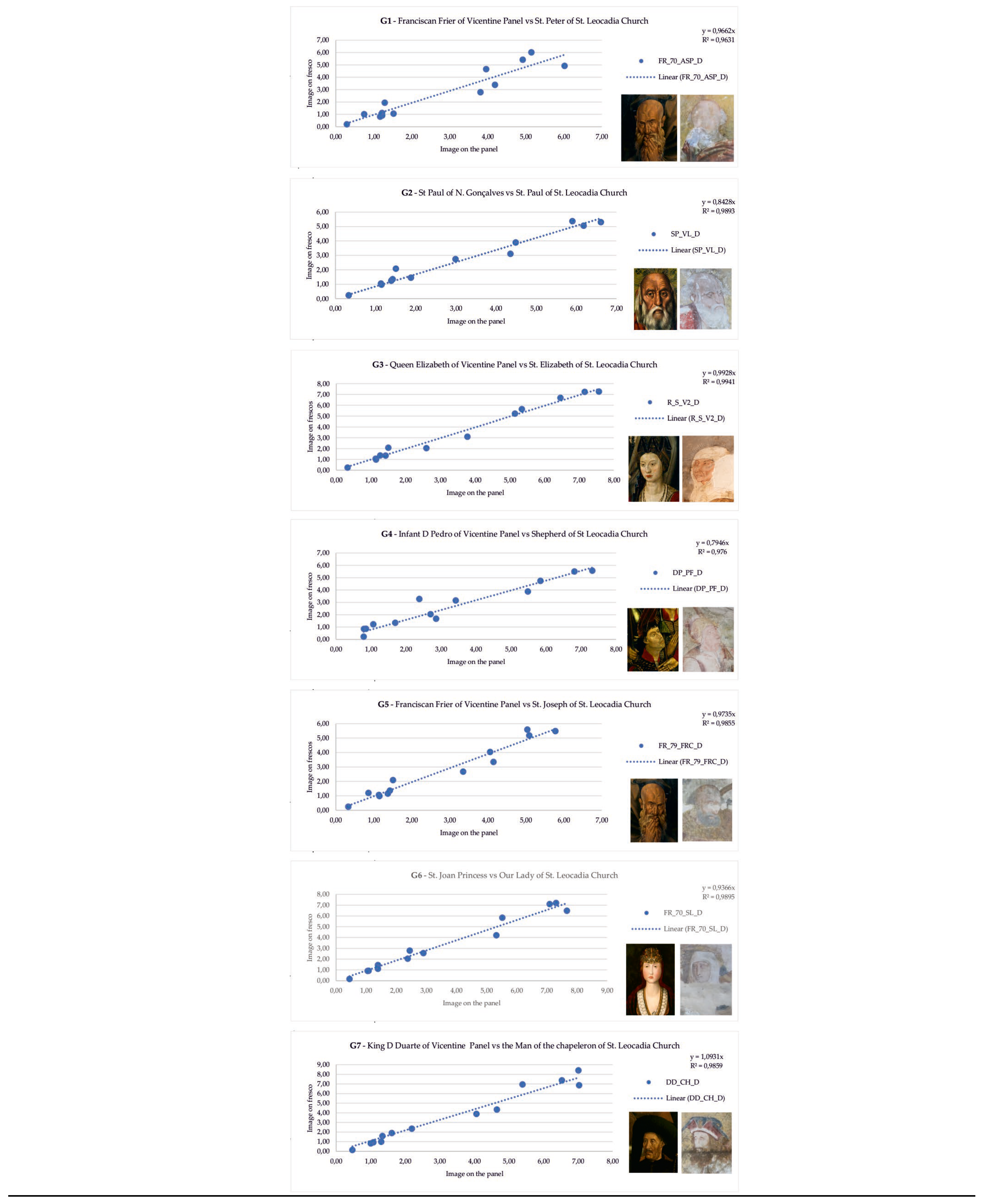
| Image Code | Original Measurements |
Ratios | All Values | |||
|---|---|---|---|---|---|---|
| E | D | E | D | E | D | |
| FR_70_ASP | 1 | 0,912 | 1 | 0,702 | 1 | 0,946 |
| SP_VL | 1 | 0,983 | 1 | 0,914 | 1 | 0,984 |
| R_S_V2 | 1 | 0,989 | 1 | 0,914 | 1 | 0,992 |
| DP_PF | 1 | 0,981 | 1 | 0,978 | 1 | 0,963 |
| FR_79_FRC | 1 | 0,966 | 1 | 0,914 | 1 | 0,977 |
| FR_70_SL | 1 | 0,975 | 1 | 0,993 | 1 | 0,985 |
| DD_CH | 1 | 0,963 | 1 | 0,961 | 1 | 0,983 |
Disclaimer/Publisher’s Note: The statements, opinions and data contained in all publications are solely those of the individual author(s) and contributor(s) and not of MDPI and/or the editor(s). MDPI and/or the editor(s) disclaim responsibility for any injury to people or property resulting from any ideas, methods, instructions or products referred to in the content. |
© 2023 by the authors. Licensee MDPI, Basel, Switzerland. This article is an open access article distributed under the terms and conditions of the Creative Commons Attribution (CC BY) license (http://creativecommons.org/licenses/by/4.0/).





